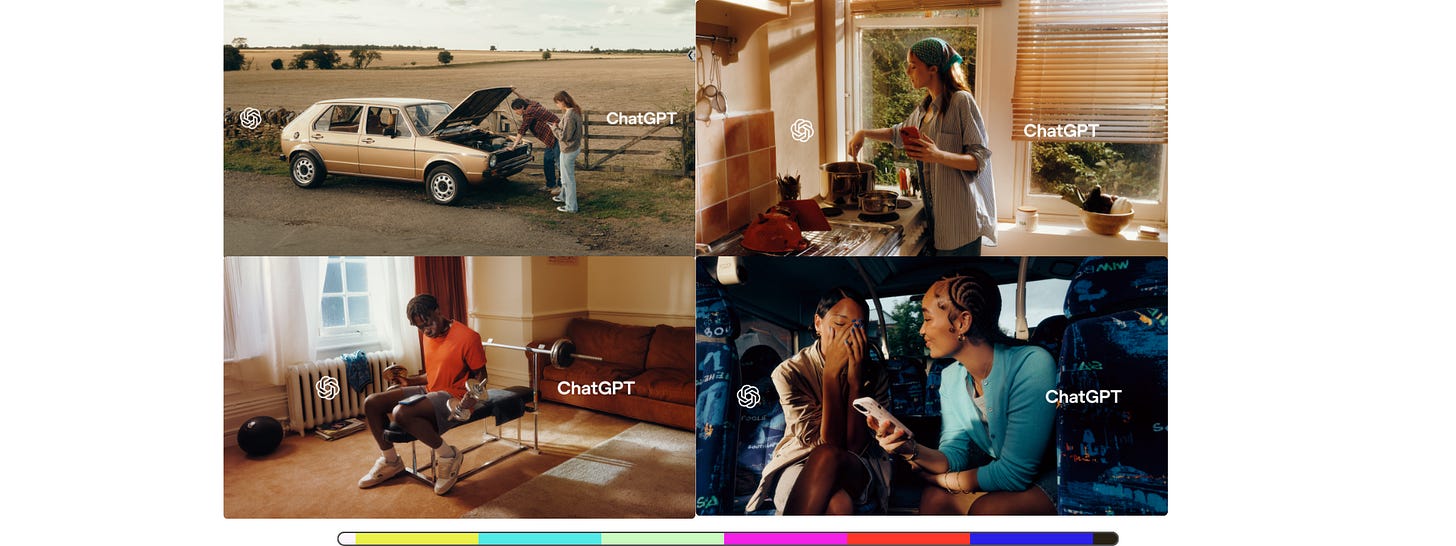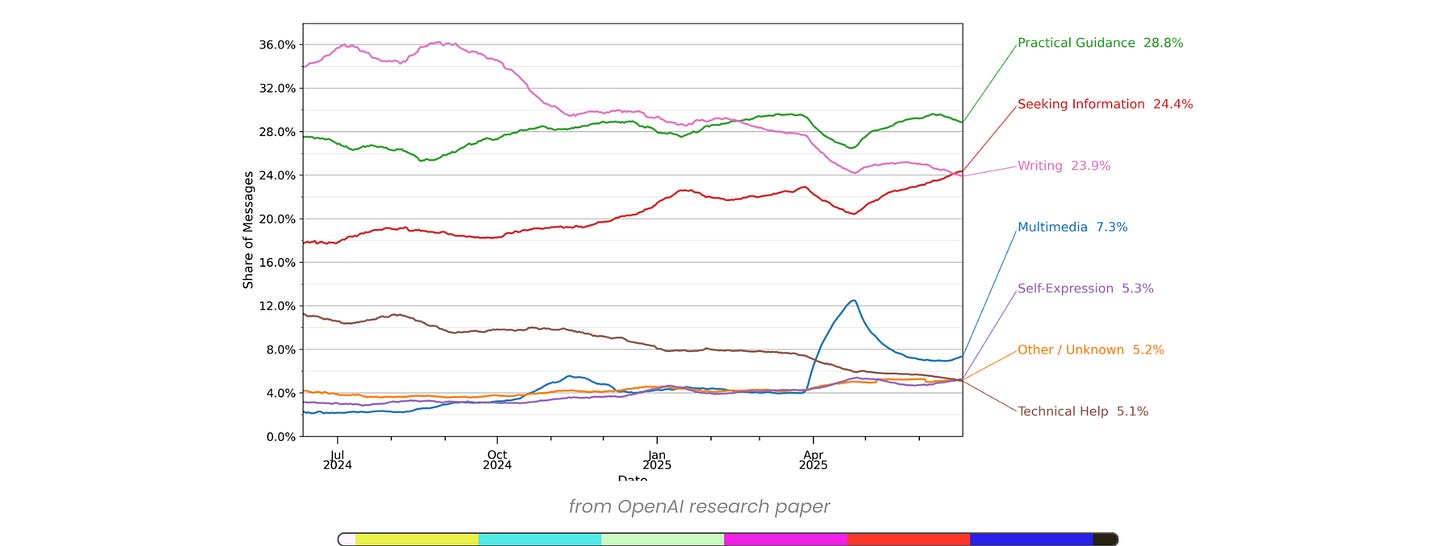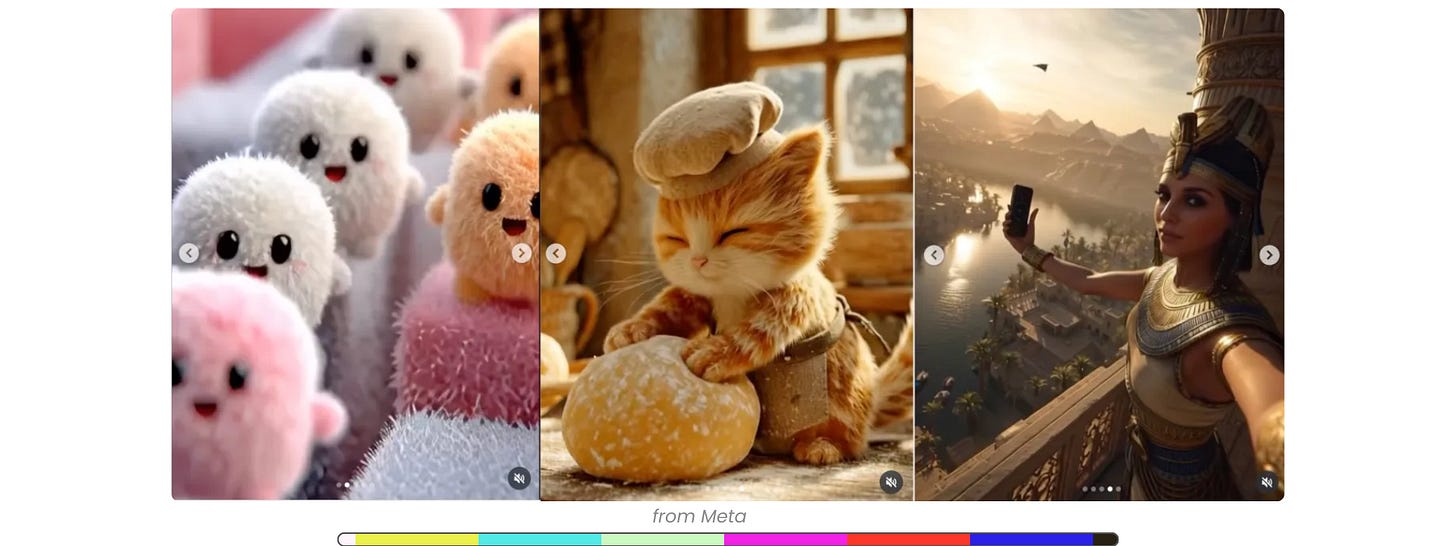AI: Everything Everywhere All At Once
· Claude vs Chat · FOOM & Vibes · Workslop ·
AI is at work, in music, in words, in video, in streams, in feeds. AI is not involved as much when humans market AI to us. This week I have brought together stories that offer windows into the state of AI in so much of our daily lives. Some parts will make you nod knowingly, some will have you shake your head. Other bits might make you smile, sigh or scream.
Hand crafted sans AI. Enjoy!
☝🏽Busy? Lazy? Multitasky? Click play above and let me read this to you.
Curated/Cuts: Claude & ChatGPT both drop brand campaigns. They’re similar… and different.
Use, AI: How are people using ChatGPT? Data suggests its the internet in a box.
Watch, AI: Two new video feeds around AI, one with the promise of gen-AI doomscrolling.
Write, AI: there are already shifts in the way we communicate.
Listen, AI: Spotify’s attempts to manage it on the platform.
Work, AI: Say hello to ‘workslop’. You may already know it.
🎬 Curated/Cuts.
1. Keep Thinking, solvers
Anthropic’s spot for ‘Claude’ pitches it as something built “for problem solvers”.
They’ve gone for a very tactile vibe. Overly tech /cyber/ machine imagery or tones? No, thank you.
Humans, many humans.
4:3 aspect ratio, ah, that retro-warmth.
Music that feels hand made.
An old school feel to the voice- a radio read, a newscaster maybe.
Look at all the humans, they are people who do, who touch and make and craft and build, and swim and drive and play; they are not keyboard Generals conjuring a new world from their ergonomic chairs.
After a choppy start, the spot settles into a chaotic but human flow.
With ‘Keep Thinking’ as the campaign line, it is trying to make us feel less like AI is about cognitive offloading, or making us lazy or dumb; not a short cut. But, in fact, that their product will drive us to think.
This also tries to push away the ‘AI is a threat’ feel and bring it back to the enabler, collaborator space. That is apart from OpenAI’s distinctly techy vibe earlier this year.
With AI backlash a real thing (though you wouldn’t know it on Linkedin, would you!?), we can expect more such comms to ‘humanise’ the space. Think “If you’re human and you know it” which I featured recently from World.org.
Director: Daniel Wolfe · DOP: André Chemetoff · Editor: Dominic Leung ·
Creative: Mother · Felix Richter ·
Production: · Love Song · VFX STRAY · Electric Theatre Collective · Post: Studio Private
2. ChatGPT, please make me an ad?
ChatGPT has their first proper brand campaign out as well. “Turning everyday prompts into little movies’ is the ambition. From a craft and creative perspective, it is nicely achieved.
Three spots back to back here- ‘Dish’, ‘Pull Up’ & ‘Road Trip’:
CMO Kate Rouch says, “It’s important for people to understand that we’re in this true technological revolution, and we don’t all have the same vision for how this will go.”
from Isle of Any · SMUGGLER · Miles Jay · Toby Treyer-Evans · Laurie Howell ·
My Take:
Given how close they have dropped, one can’t help but compare this to Claude/Anthropic’s piece. Both look to humanise the role of AI in our lives, take away the distant, tech-dominance feel and make it more personable (and, in Chat’s case, personal).
The difference? Claude wants a larger, more soulful place; these ChatGPT missives reveal a preference to stay inserted into daily life.
Not a small amount of the AI backlash is precisely because AI is viewed as taking away agency from us, insidiously pretending to add value to every little facet of our life (and the corporations around us). To that crowd, ChatGPT’s message might be a bit of a miss.
On the flip side, it can work pitching the service not as some techy solution or productivity hack, but our partner in stumbling from one week to the next.
What say?
It is a push to a consumer market that by all accounts is a tiny bit of OpenAI’s business. I also have a sneaking though that this campaign could quickly feel generic- as much marketing ‘AI’ in general, as much as ChatGPT?
Mark Ritson has a scathing look at these efforts + the AI scene overall.
“OpenAI’s campaign is an admission that for all the talk of disruption and democratization, AI companies have failed at the most basic task of all: making people care.”
In some ways, the Chat GPT campaign has some support from the recent data around usage of the platform:👇🏼
Use, AI
You might have spotted the report on how people are actually using ChatGPT. Note, this has been done by researchers at OpenAI itself, in collaboration with Harvard & Duke Universities. The main usage, we are told, is around practical advice, information searches, and writing. Sounds like the internet.
John Herrman had a look at this, with this worthwhile note connecting it to the idea that LLMs are better understood as “cultural and social technologies” than in terms of intelligence and autonomy:
“ChatGPT, for many of its users, is a way to access, remix, summarize, retrieve, and sometimes reproduce information and ideas that already exist in the world; in other words, they use this one tool much in the way that they previously engaged with the entire web — arguably the last great “cultural and social technology” — and through a similar routine of constant requests, consultations, and diversions.
One doesn’t get the feeling from this research that we’re careening toward uncontrollable superintelligence… but it does suggest users are more than comfortable replacing and extending many of their current online interactions — searching, browsing, and consulting with the ideas of others — with an ingratiating chatbot simulation.”
Watch, AI
FOOM!
Runway has launched a 24/7 live feed of content, FOOM! They call it a broadcast of ‘AI culture’ that will have “weekly shows, interviews, films, research discussions, endless inspiration, livestreams and experimental new programming”. Its, erm, a TV channel, except its on the internet, has no programme guide,… and yes, is all to do with AI (not necessarily all AI-generated).
I have seen on this feed- a discussion between creative people on the place of AI in their process, a piece on passed grandmothers, faux-emotional meditations on what is real, many deep, mind bending, provocative, derivative sci-fi shorts, and plenty of visuals I have had to just turn off.
But hey- if you have a show you want to host or content you want to stream? Reach out at watchfoom.com.
Sorry if I sound disparaging. Its an interesting effort, and means there is plenty of very global perspectives ( I have heard at half a dozen languages), and is a good way to lean in to the generative AI space. And, not everything needs to have been created by Runway ( I think), so it is not a pure marketing tool. Let’s see what comes of this.
Vibes
Elsewhere, Meta and has launched Vibes, a new feed within their MetaAI app (who uses that?).
What is Vibes? A scroll of only AI-generated short videos. Essentially, genAI version of Tiktok.
Exactly what we have been waiting for! (But wait, the videos are “expressive”, per Zuck)
Why do we have this, the very definition of AI doomscrolling ?
Let me know if you figure it out.
🔪 (The Daily Show & Michael Kosta ripped into it)
Write, AI
Writing, Reacting & Trusting with AI
AI impacts how we write and is changing how we interact. Researchers are already diving into shifts around how we communicate, as a result of ChatGPT. They see this linguistic influence accelerating into something much larger. It is leading to a loss of trust and an instinctive questioning of those using it.
So we are improving AI communication, while fostering suspicion for it.
Clearly, preserving linguistic diversity lies at the centre of this. Yet, it is also about protecting the imperfections that actually build trust.
When everyone around us starts to sound “correct,” we lose the verbal stumbles, regional idioms, and off-kilter phrases that signal vulnerability, authenticity, and personhood.
The deepest risk of all is not linguistic uniformity, but losing conscious control over our own thinking and expression.
Listen, AI
Spotify’s steps with AI
I wrote last week about how AI is forging its way into music, and the general lack of proactive responses from the likes of Spotify & Apple. Now, Spotify has announced it will:
improve rules around impersonation, with clarity on AI-cloned voices (think deepfakes);
a new filter to combat spam tactics;
developing a system for artists to label if they have used AI in any part of the process.
This last one, they clarify, is “a way to clearly indicate where and how AI played a role in the creation of a track—whether that’s AI-generated vocals, instrumentation, or post-production.”
However, as Ashley Carman points out, this is an opt-in. The onus is not on Spotify but on artists (and ’artists’) appropriately labelling their content as made with AI. Which also means there’s no penalty for artists or labels who don’t use this system. Spotify is kinda straddling the fence, hoping to appease fans and labels alike.
The streamer has also commented on the ghost music phenomenon, which they’ve been accused of being complicit in. I touched on this too, last week. Spotify called such claims, “categorically and absolutely false.”
“The industry needs a nuanced approach to AI transparency, not to be forced to classify every song as either “is AI” or “not AI.”
While there is undoubtedly lot of nuance required, the listeners /fan/ general reactions tend to centre around a binary ‘AI vs Human’ stance. Like it or not, streaming platforms face the role of having to step in and be leaders.
A reminder- that streamer Deezer marks all AI-generated content, as a rule.
Work, AI
Workslop
Efficiency. Productivity. Speed. Cost.
Often overvalued and overused, these buzzwords can lose meaning quickly.
They also are at the heart of the grand AI promise: its easier! faster work! stronger output! powered-up teams! Onward!
I’ve had a few conversations grappling with this— everyone wants to be ahead of the curve, not missing out. But embracing those cheers without nuance is merely jumping onto a bandwagon.
Now, HBR’s new study draws the line between blind embrace and needed scepticism.
They’ve coined the term ‘workslop’ to describe low-effort AI output that looks fine but adds little, often creating more work for colleagues. The study finds that majority of AI-assisted work falls into this category.
“We define workslop as AI generated work content that masquerades as good work, but lacks the substance to meaningfully advance a given task.”
The study also identifies harms, like a “Workslop Tax”, where the cognitive offloading actually lands on the shoulders of another human, not the machine.
I was also struck by the social and emotional costs, like how to diplomatically respond to receiving workslop; or the erosion of trust when colleagues consistently lean on AI for sub par work in the name of efficiency.
The recommendations?
One, mindset- use AI to enhance creativity and productivity, not as a shortcut. In my experience, I too often see the opposite- eyes light up at the potential for ‘less work’, from both workers and employers/clients.
Second, the value and complexity of collaboration, which doesn’t shrink, but grows with AI.
Well worth a read- and not just for those in offices.
Do you already see ‘workslop’ in your daily work?
I also make some videos on some of these stories. If you like watching, use your thumb to scroll across these, on IG or Youtube or Linkedin.
The irony is delicious. The industry that promised to revolutionize everything has been forced to embrace the most traditional marketing approach imaginable.
Turns out you can’t algorithm your way to distinctiveness.
Welcome to marketing, tech bros.
The water’s lovely once you stop trying to disrupt it.
_Mark Ritson on ChatGPT’s use of ‘traditional’ approaches.












